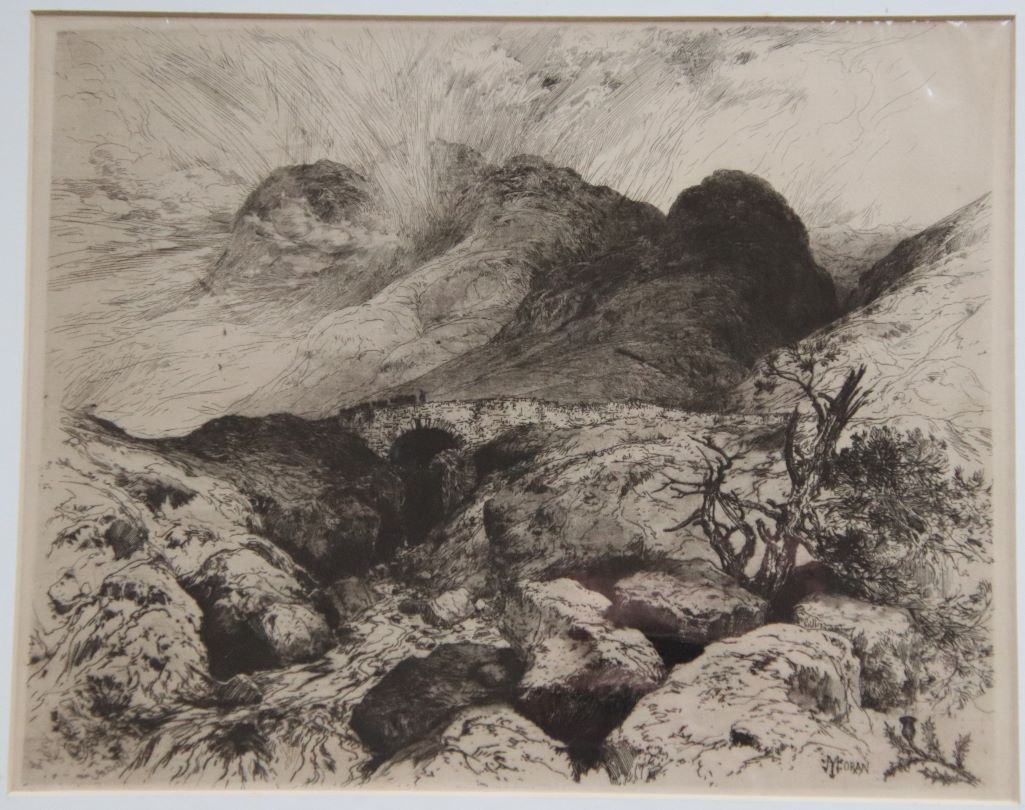
The Bridge, Pass of Glencoe, Scotland by Thomas Moran
This is an etching by the famous American landscape artist Thomas Moran. The subject is The Bridge, Pass of Glencoe, Scotland. It was created in 1882 and published in the American Art Review. The etching was done by Moran, but is after a watercolor he created that is currently on display at the Gilcrease Museum. It was created during a trip to Scotland with his wife, a native Scot, Mary Nimmo Moran who was also an artist and etcher (see one of her pieces in our inventory). It depicts a stone arch bridge crossing a flowing stream that flows from the center of the image down to the lower left. A wagon or train of wagons has just crossed the bridge. A gnarled tree occupies the right foreground. The scene is backed by mountains shrouded with clouds and sunbeams coming through. Moran's handling of the scene is dynamic and energetic with spectacular use of light and shadow. It is signed with his monogram T Moran lower right in the plate along with his familiar thistle remarque. The image is well-struck and inked. There is no fading or paper damage. The plate size is 11.75 x 9.5 inches. It is a free sheet mounted on mat board. the full size of the mounted print is 20 x 16.75 inches. It's in excellent condition. A fantastic etching by one of the greatest American artists.
Thomas Moran (1837-1925) Thomas Moran is one of the best-known landscape painters of the late 19th and early 20th centuries in the United States. He is primarily associated with the Hudson River School but is also known for his Western landscapes that rival those of Albert Bierstadt, Thomas Hill, and William Keith who along with Moran are sometimes grouped as the Rocky Mountain School. He was born in England, but moved with his family to the United States when he was just 7 years old. His artistic training began through an apprenticeship with a firm specializing in wood engraving. While this provided a grounding in printmaking, Moran described the work as “tedious”. On his own he began to create watercolors. His talent was recognized, and he was moved to the position of illustrator. He studied informally with a local artist, James Hamilton, but at this time he became familiar with the work of J. M. W. Turner, the famous English landscape painter. This influence moved Moran to his preferred media of watercolor and oil painting. However, he continued printmaking and is identified as one of the leaders of the “Etching Revival” in the United States and England. This interest was no doubt nurtured through his marriage to Mary Nimmo Moran, a noted Scottish etcher. He was a member of the New York etching club. Even though his major output was his paintings, there is one more connection to printmaking. In the late 19th century, a new printing technique called chromolithography was developed. Moran recognized the commercial opportunity and created chromolithographs of his paintings that allowed mass consumption of the relatively inexpensive prints, greatly enhancing his visibility as an artist. He is most well known for his work in Yellowstone and the Grand Tetons. Mount Moran in the Grand Teton National Park is named for him. His work is held by most major museums in the United States and abroad.
Price: $550
Size: 20 x 16.75 inches
Plate Size: 11.75 x 9.5 inches
Condition: Excellent
Medium: Etching
Subject: Landscape
Shipping, handling and insurance is included for purchases within the US and Canada. We ship internationally. Please contact us for shipping cost and invoice information.

